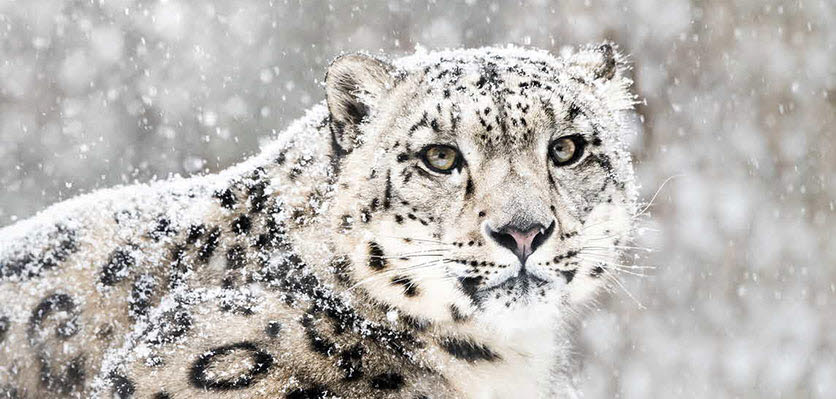
The magnificent snow leopard (Panthera uncia), once classified as an endangered species, has now been downgraded to vulnerable according to the International Union for Conservation of Nature (IUCN) Red List of Threatened Species.1
Known as the ‘ghosts of the mountains’, snow leopards inhabit the mountain ranges of Central and South Asia, bordering 12 countries (Afghanistan, Bhutan, China, India, Kazakhstan, Kyrgyzstan, Mongolia, Nepal, Pakistan, Russia, Tajikistan, and Uzbekistan). Their notoriously elusive nature, a consequence of being a solitary species inhabiting extremely treacherous and remote terrains, makes studying their behaviour and habitat very difficult. It also makes an accurate estimation of their numbers almost impossible, reflected in the scarcity of substantial data on overall population numbers.
Recent estimations put the snow leopard population at anywhere between 3920 and 7980, with an estimated 2710–3386 mature individuals.1 Their numbers are thought to have dwindled to a precariously low level because of poaching (for their fur and traditional medicines) and habitat destruction. They have also frequently been killed by local farmers in retaliation or as a preventative action to stop snow leopards attacking their herds. Given that at least 40% of people who live within the hunting range of snow leopards live below the poverty line, any loss of farming stock has a significant effect on their livelihood.2
The IUCN predicts increased farming, intensification of infrastructure development and mineral mining could result in a 10% decline in the snow leopard population over the next three generations (22.62 years). Why then, you may ask, has their status been downgraded to vulnerable?
The IUCN has acknowledged that its 2008 estimate of a 20% decline over two generations (16 years) in a population comprising less than 2500 mature individuals, classifying snow leopards as endangered, was overestimated. What’s more, the IUCN cites numerous conservation, education and community programs, alongside a range of political and legislative changes since the 1990s that have substantially curbed the unauthorised killing of snow leopards. As a result, snow leopard populations in certain regions are predicted to stabilise and even increase.
However, some experts believe the downgrading of the snow leopard’s endangered status is unwarranted and that the population estimates used by the IUCN are grossly overestimated. They argue that the sampling of less than 2% of the snow leopard’s habitat range has not been conducted to a scientifically acceptable level. They further claim there is no evidence to suggest that snow leopard numbers have stabilised and the species is still under threat from illegal poaching, retaliatory killing, habitat and prey loss, and global warming.3 And of even greater concern is that this downgrading will affect future funding for conservation efforts, which may further impact snow leopard numbers.
Notable opposition to the downgrading of the endangered status of the snow leopard comes from The Global Snow Leopard & Ecosystem Protection Program (GSLEP).4
Key conservation programs that focus on stabilising snow leopard populations: 20 by 2020
GSLEP has established a ‘20 by 2020’ program, which aims to establish 20 separate, robust snow leopard colonies across their 12-country habitat range by 2020.5
IUCN-SOS
This is a joint community-based conservation program with IUCN and the Save Our Species organisation working to educate and provide economic support programs to local communities in Pakistan's Gilgit-Baltistan Province in an effort to cease poaching and retribution killing of snow leopards.6
Snow leopard survival strategy (SSLS)
This report summarises snow leopard territory, behaviours and threats to the species. It identifies specific areas where more research is required, outlining appropriate conservation, education and policy measures to help manage these threats.7
References
- McCarthy T, Mallon D, Jackson R et al. Panthera uncia. The IUCN Red List of Threatened Species 2017: e.T22732A50664030. http://www.iucnredlist.org/details/summary/22732/0 Accessed September 2017.
- Global Snow Leopard & Ecosystem Protection Program. Retaliation or protective killings. http://www.globalsnowleopard.org/the-snowleopard/threats/retaliation-or-protective-killings/. Accessed September 2017.
- Khadka NS. Scientists split over snow leopard status. BBC News http://www.bbc.com/news/science-environment-41030489. Accessed September 2017.
- Global Snow Leopard & Ecosystem Protection Program. Statement of concern regarding the status of the snow leopard on the IUCN Red List. http://www.globalsnowleopard.org/blog/2017/09/26/statement-of-concern-regarding-the-status-of-the-snow-leopard-on-the-iucn-red-list/. Accessed September 2017.
- Global Snow Leopard & Ecosystem Protection Program. The first step: 20 by 2020. http://www.globalsnowleopard.org/our-work/the-first-step-20-by-2020/. Accessed September 2017.
- Save Our Species. Community-based incentive programs to promote snow leopard conservation in Gilgit-Baltistan province, Pakistan. http://www.saveourspecies.org/projects/cats/community-based-incentive-programs-promote-snow-leopard-conservation-gilgit-baltistan. Accessed September 2017.
- Snow Leopard Network. Snow leopard survival strategy: revised 2014 version. Snow Leopard Network, Seattle, WA, USA, 2014. http://snowleopardconservancy.org/wpcontent/uploads/2014/10/Snow_Leopard_Survival_Strategy_2014.1 Accessed September 2017.
This article appeared in the November 2017 issue of the Australian Veterinary Journal
